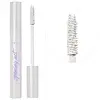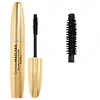What's inside
What's inside
 Key Ingredients
Key Ingredients

 Benefits
Benefits

 Concerns
Concerns

 Ingredients Side-by-side
Ingredients Side-by-side

Water
Skin ConditioningEthylene/Va Copolymer
Emulsion StabilisingCopernicia Cerifera Wax
Hydrogenated Olive Oil Stearyl Esters
Emulsion StabilisingGlyceryl Stearate
EmollientNylon-12
Cetearyl Stearate
Skin ConditioningStearic Acid
CleansingPalmitic Acid
EmollientTriethanolamine
BufferingSilica
AbrasiveHydrated Silica
AbrasivePhenoxyethanol
PreservativeHydroxyethylcellulose
Emulsion StabilisingHydrogenated Castor Oil
EmollientSynthetic Wax
AbrasiveCellulose
AbsorbentDimethicone
EmollientBabassu Oil Glycereth-8 Esters
EmulsifyingCetearyl Alcohol
EmollientAscorbyl Palmitate
AntioxidantEthylhexylglycerin
Skin ConditioningDisodium Phosphate
BufferingPolysorbate 60
EmulsifyingTocopherol
AntioxidantSodium Phosphate
BufferingWater, Ethylene/Va Copolymer, Copernicia Cerifera Wax, Hydrogenated Olive Oil Stearyl Esters, Glyceryl Stearate, Nylon-12, Cetearyl Stearate, Stearic Acid, Palmitic Acid, Triethanolamine, Silica, Hydrated Silica, Phenoxyethanol, Hydroxyethylcellulose, Hydrogenated Castor Oil, Synthetic Wax, Cellulose, Dimethicone, Babassu Oil Glycereth-8 Esters, Cetearyl Alcohol, Ascorbyl Palmitate, Ethylhexylglycerin, Disodium Phosphate, Polysorbate 60, Tocopherol, Sodium Phosphate
Water
Skin ConditioningParaffin
PerfumingCI 77499
Cosmetic ColorantPalmitic Acid
EmollientStearic Acid
CleansingBeeswax
Emulsion StabilisingCholesterol
EmollientCopernicia Cerifera Wax
Triethanolamine
BufferingCI 77007
Cosmetic ColorantNylon-12
Cetyl Esters
EmollientGlycerin
HumectantHydroxyethylcellulose
Emulsion StabilisingPhenoxyethanol
PreservativeAminomethyl Propanediol
BufferingPanthenol
Skin ConditioningPropylene Glycol
HumectantHydrated Silica
AbrasiveEthylhexylglycerin
Skin ConditioningAscorbyl Palmitate
AntioxidantDisodium Phosphate
BufferingPolysorbate 60
Emulsifying1,2-Hexanediol
Skin ConditioningCaprylyl Glycol
EmollientTocopherol
AntioxidantSodium Phosphate
BufferingBenzoic Acid
MaskingMyristoyl Pentapeptide-17
Skin ConditioningSodium Benzoate
MaskingGlyoxal
AntimicrobialWater, Paraffin, CI 77499, Palmitic Acid, Stearic Acid, Beeswax, Cholesterol, Copernicia Cerifera Wax, Triethanolamine, CI 77007, Nylon-12, Cetyl Esters, Glycerin, Hydroxyethylcellulose, Phenoxyethanol, Aminomethyl Propanediol, Panthenol, Propylene Glycol, Hydrated Silica, Ethylhexylglycerin, Ascorbyl Palmitate, Disodium Phosphate, Polysorbate 60, 1,2-Hexanediol, Caprylyl Glycol, Tocopherol, Sodium Phosphate, Benzoic Acid, Myristoyl Pentapeptide-17, Sodium Benzoate, Glyoxal
Ingredients Explained
These ingredients are found in both products.
Ingredients higher up in an ingredient list are typically present in a larger amount.
Ascorbyl Palmitate is created by combining pure Vitamin C and palmitic acid. It is an antioxidant and helps reduce hyperpigmentation.
This ingredient is a more stable version of Vitamin C, meaning it does not disintegrate as quickly when exposed to sunlight. However, studies show it does not penetrate skin as well as pure Vitamin C.
Ascorbyl Palmitate is oil soluble.
Read more about other types of Vitamin C:
Learn more about Ascorbyl PalmitateCopernicia Cerifera Wax comes from a palm tree native to Brazil; another name for this ingredient is Carnauba Wax.
This ingredient is used to thicken texture and also leaves behind a film when applied.
Fun fact: This wax has the highest melting point of all natural waxes and low solubility.
Learn more about Copernicia Cerifera WaxDisodium Phosphate is a water-soluble powder used as a pH adjuster.
Ethylhexylglycerin (we can't pronounce this either) is commonly used as a preservative and skin softener. It is derived from glyceryl.
You might see Ethylhexylglycerin often paired with other preservatives such as phenoxyethanol. Ethylhexylglycerin has been found to increase the effectiveness of these other preservatives.
Hydrated Silica is a type of silicon dioxide. It is called 'hydrated silica' because it is silica with extra bonded water atoms.
It is an absorbent and abrasive, meaning it is exfoliating.
Silica is often used for absorption and can help reduce shine when products are applied.
Learn more about Hydrated SilicaHydroxyethylcellulose is used to improve the texture of products. It is created from a chemical reaction involving ethylene oxide and alkali-cellulose. Cellulose is a sugar found in plant cell walls and help give plants structure.
This ingredient helps stabilize products by preventing ingredients from separating. It can also help thicken the texture of a product.
This ingredient can also be found in pill medicines to help our bodies digest other ingredients.
Learn more about HydroxyethylcelluloseNylon-12 is a polymer. It is derived from 12-aminododecanoic acid, an omega-amino fatty acid
According to a manufacturer, it is a talc substitute. Like talc, nylon-12 gives products a satin feel. The manufacturer also claims this ingredients does not block pores and has moderate oil absorption.
This ingredient may not be reef-safe.
Learn more about Nylon-12Palmitic Acid is a fatty acid naturally found in our skin and in many plant and animal sources. In cosmetics, it is usually derived from palm oil. It serves many purposes in skincare, acting as a cleanser, emollient, and emulsifier.
As an emollient, palmitic acid helps soften and smooth the skin by preventing water loss. In cleansers, it helps remove oil and dirt while creating foam.
Its emulsifying properties help stabilize products by keeping water and oil-based ingredients from separating.
This may not be suitable for fungal acne-prone skin, as fatty acids like this can sometimes trigger breakouts in sensitive individuals.
Learn more about Palmitic AcidPhenoxyethanol is a preservative that has germicide, antimicrobial, and aromatic properties. Studies show that phenoxyethanol can prevent microbial growth. By itself, it has a scent that is similar to that of a rose.
It's often used in formulations along with Caprylyl Glycol to preserve the shelf life of products.
Polysorbate 60 is used to help stabilize products. It is a surfactant and emulsifier. These properties help keep ingredients together in a product. Surfactants help reduce surface tension between ingredients with different states, such as liquids and solids. Emulsifiers help prevent oils and waters from separating.
Polysorbate 60 is sorbitol-based and created from the ethoxylation of sorbitan. Ethoxylation is a chemical reaction used to add ethylene oxide. Sorbitan is a the dehydrated version of sorbitol, a sugar found in fruits.
In this case, the 60 comes from reacting 60 units of ethylene oxide with sorbitan.
Polysorbates are commonly used in medicine and foods.
Learn more about Polysorbate 60Sodium phosphate is a group of inorganic sodium salts (mono, di, and tri-sodium phosphate). It has pH buffering, chelating, and stabilizing properties.
This means it helps maintain a formula's acidity, enhances preservative performance, and prevents unwanted changes caused by metal ions or hard water.
Sodium phosphate is considered safe for use in cosmetics according to the Cosmetic Ingredient Review (CIR); it also has a long-established food-grade safety rating as well.
Though some sources claim sodium phosphate can help "energize skin cells", this claim is not strongly supported by independent scientific studies.
Learn more about Sodium PhosphateStearic Acid is a fatty acid. It is an emollient, emulsifier, and texture enhancer.
As an emollient, stearic acid helps soften skin. It aids the skin's protective barrier by preventing water loss. It also provides a gentle cleansing effect without stripping away natural oils.
Stearic acid may also be used to enhance the texture of products. It can add volume and stabilize ingredients such as water and oil. This can help water and oil ingredients from separating.
Sources of stearic acid include animal or vegetable fats/oils such as coconut or shea. It can be naturally found in butter, cocoa butter, shea butter, vegetable fats, and animal tallow.
This ingredient may not be Malassezia folliculitis, or fungal-acne safe.
Learn more about Stearic AcidTocopherol (also known as Vitamin E) is a common antioxidant used to help protect the skin from free-radicals and strengthen the skin barrier. It's also fat soluble - this means our skin is great at absorbing it.
Vitamin E also helps keep your natural skin lipids healthy. Your lipid skin barrier naturally consists of lipids, ceramides, and fatty acids. Vitamin E offers extra protection for your skin’s lipid barrier, keeping your skin healthy and nourished.
Another benefit is a bit of UV protection. Vitamin E helps reduce the damage caused by UVB rays. (It should not replace your sunscreen). Combining it with Vitamin C can decrease sunburned cells and hyperpigmentation after UV exposure.
You might have noticed Vitamin E + C often paired together. This is because it is great at stabilizing Vitamin C. Using the two together helps increase the effectiveness of both ingredients.
There are often claims that Vitamin E can reduce/prevent scarring, but these claims haven't been confirmed by scientific research.
Learn more about TocopherolTriethanolamine is an emulsifier and pH adjuster. It is created using ethylene oxide and ammonia. This gives Triethanolamine a nitrogen core and a similar scent to ammonia.
As an emulsifier, it prevents ingredients from separating and enhances texture by adding volume to a product.
PH adjusters are common in cosmetic products. The pH of a product can affect the effectiveness of other ingredients. A product with a high pH may also irritate the skin.
Learn more about TriethanolamineWater. It's the most common cosmetic ingredient of all. You'll usually see it at the top of ingredient lists, meaning that it makes up the largest part of the product.
So why is it so popular? Water most often acts as a solvent - this means that it helps dissolve other ingredients into the formulation.
You'll also recognize water as that liquid we all need to stay alive. If you see this, drink a glass of water. Stay hydrated!
Learn more about Water